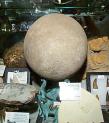Size Of Eggs
Large advances have been made in the past twenty years on the subject of dinosaur eggs and are fast becoming a recognized subject of paleontology study. As, has already been said, egg sightings are exceedingly rare. We now know, however, from thorough examination of these eggs a considerable amount about the microscopic and macroscopic structure of these eggs. However there is still much more to learn about dinosaur eggs to get a half-decent overall picture on the structure and evolution of dinosaur eggs.

Eggs and eggshells due to their nature, their fragile structure and biomineralogical composition are more easily affected by environmental factors than bones and teeth. For example the amount of calcium used by the embryo (calcium from the shell) will determine the hardness of the shell. There is a table printed out to show the number of reasons that influence preservation of eggs.
The story begins in 1922 when an expedition from the American Museum of Natural History to Mongolia discovered, at a locality known as Shabarakh usu, a large and rich deposit of small dinosaur skeletons. These skeletons belonged to the ancestral horned dinosaur Proceratops. Lying next to the remains were numerous fossil eggs arranged in circular nests. There was also countless thousands of eggshell fragments. This remarkable discovery in the Gobi desert makes it the 'classic site' for paleontology. The microstructure of these eggs has been intensively studied by numerous palaeontologists-vans Straelan (1925), Schwarz (1961) and Erben (1978).
tThe eggs have been classified into 12 parataxonomic families, by Mikhailov, of which 9 families are known from the Gobi desert. However the most abundant eggs belonged to the Proceratops and these remain the most famous dinosaur eggs ever to be discovered.
Another case study was recently discovered by palaeontologists from the American Museum of Natural History in New York. While studying in Mongolia's Gobi Desert, came across a Oviraptor skeleton sitting on a clutch of eggs in a typical bird fashion incubation position. This is so far the best evidence for the idea that dinosaurs brooded their own eggs. This same site was also interesting to the museum as the palaeontologists also discovered the jaw of an embryonic Dromaeosaur with the eggs. This could be the remains of a meal for the expectant parents or the new born, or it is possible that the Dromaeosaur could have laid its own eggs in the nest of the Oviraptor. Thus showing the same behaviour as the modern cuckoo, another link to the theory of dinosaurs and their evolutionary trait to birds.
With respect to how dinosaurs raised their young there is much speculation and no true evidence, but as the remains of juveniles and adults are often found together, both in nesting sites and bone beds, there is indication of care.